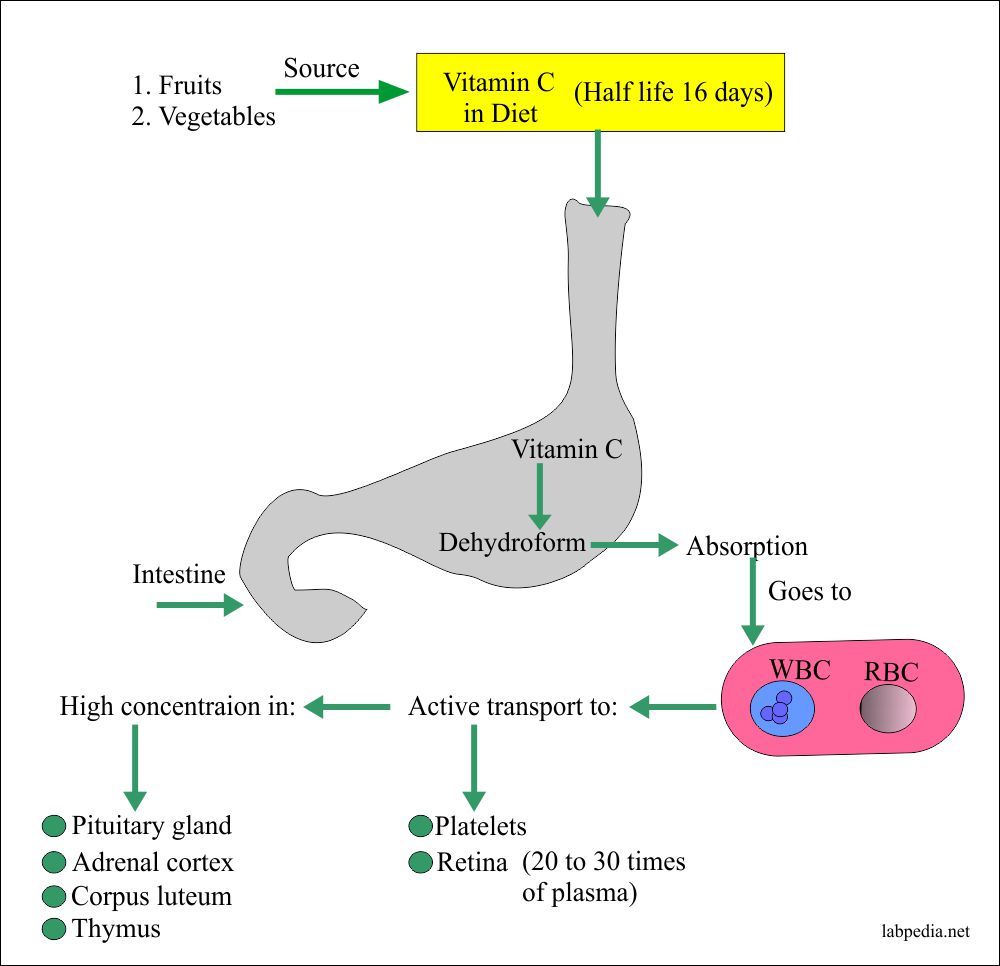Vitamin C (Ascorbic acid)
Sample
- Serum or plasma can be used.
- The whole blood for vitamin C is stable for 3 hours when refrigerated.
- Deproteinized the serum or plasma with metaphosphoric acid (5 g/dL) or trichloroacetic acid (10 g/dL).
Precautions
- Avoid hemolysis.
Pathophysiology
- This is a white crystalline solid which is easily soluble in water and easily absorbed from the stomach and intestine.
- This is strong reducing compounds and the source is dietary ingestion.
- Body stores can last for months.
- Vit. C has a very important function in our body.
- Vitamin C serves as a reducing agent in several hydroxylation reactions in the body.
- This exists in two forms:
- L-ascorbic acid.
- Dehydroascorbic acid (Ascarbone).
- This form is more labile.
- Absorption is mainly from the stomach.
- This has passive entry into the WBCs and RBCs.
- Active entry is into glandular tissue like the pituitary gland, adrenal cortex, corpus luteum, and thymus. While concentration in the retina is 20 to 30 times more than tissue.
- Source of vitamin C:
- The best source of Vitamin C is :
- citrus fruits.
- Berries.
- Melons.
- Green pepper.
- Tomatoes.
- Raw cabbage.
- Leafy green vegetables.
- Potatoes.
- Heat can lead to the loss of vitamin C.
- Vitamin C deficiency leads to Scurvy which will show clinically:
- Hemorrhagic disorder.
- There are swollen and bleeding gums.
- There is impaired healing.
- There is anemia.
- Vitamin C is excreted in the urine. Its excretion is increased by:
- Aspirin.
- Aminopyrine.
- Barbiturates.
- Paraldehyde.
- Hydantoin.
- Vitamin C absorption:
Normal
Source 1
- Vitamin C = 0.4 to 1.5 mg/dL
- Defeciency level = <0.2 mg/dL
Other soureces
- Daily requiremtns of vitamin C:
- Infants
- 0 to 6 months = 40 mg/day
- 7 to 12 months = 50 mg/day
- Children
- 1 to 3 years = 15 mg/day
- 4 to 8 years = 25 mg/day
- 9 to 13 years = 45 mg/day
- Adolescents
- Girls 14 to 18 years = 65 mg/day
- Pregnant teens = 80 mg/day
- Breastfeeding teens = 115 mg/day
- Boys 14 to 18 years = 75 mg/day
- Adults
- Men age 19 and older = 90 mg/day
- Women age 19 years and older: = 75 mg/day
- Pregnant women = 85 mg/day
- Breastfeeding women = 120 mg/day
- Vitamin C normal range = 0.2 to 2.0 mg / 100 ml.
- Deficiency when level is < 0.2 mg/dL.
- Vitamin C level in Leucocytes = 20 to 53 µg/10^8 leucocytes.
- Deficient value when is <10 µg / 10^8 leucocytes.
- Urinary excretion of vitamin C = 8 to 27 mg/day.
Deficiency of Vit.C, Clinical effects of decreased vitamin C:
- Prolonged deficiency leads to Scurvy.
- There is an inadequate formation of intercellular substances in the connective tissue leads to:
- Swollen, tender, and sometimes bleeding into the joints.
- Gums are swollen.
- Infantile scurvy also knew Barlow’s disease, will show bayonet rib syndrome.
- There is vascular fragility leads to:
- Cutaneous bleeding and usually starts in the lower thigh and may spread to buttocks, abdomen arms, and legs.
- Petechial hemorrhage may lead to a large bruise.
- There is an ocular hemorrhage.
- Bleeding in the GI tract, kidneys, conjunctiva, and brain.
- Hemorrhage of the gingiva.
- There may be dental loss and even fractures.
- There is delayed wound healing.
- Other glands like salivary, lacrimal, and parotid may be involved.
- There may be femoral neuropathy and edema of lower extremities.
- Toxicity:
- Large doses of vitamin C for allergy and cold are not recommended.
- large doses do not cause any problems except GI upset.
- Increased oxalate stones in the kidney and urinary bladder due to acidification of urine.
Clinical Effects Of Increased Vitamin C:
- Diarrhea.
- Nausea.
- Over absorption of iron.
- A stone formation like oxalate stones.
- Effect on diabetes tests and occult blood.
Method To Measure Vit.C:
- This can be measured by:
- Photometric system
- Fluorometric and HPLC techniques can be used.
Treatment
- The daily dose of 10 mg of vit.C is sufficient to treat the clinical signs of scurvy.











0 Comments